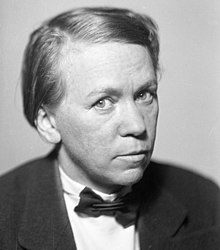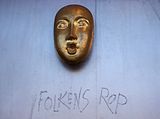Siri Derkert: Difference between revisions
→Artistic career: more accurate |
added Category:Swedish anti-war activists using HotCat |
||
| Line 135: | Line 135: | ||
[[Category:Recipients of the Prince Eugen Medal]] |
[[Category:Recipients of the Prince Eugen Medal]] |
||
[[Category:20th-century Swedish sculptors]] |
[[Category:20th-century Swedish sculptors]] |
||
[[Category:Swedish anti-war activists]] |
|||
Revision as of 20:20, 14 September 2015
Siri Derkert | |
|---|---|
 Siri Derkert in the 1940s | |
| Born | Siri Karin Derkert August 30, 1888 Stockholm, Sweden |
| Died | April 28, 1973 (aged 84) Lidingö, Sweden |
| Resting place | Lidingö churchyard 59°21′58.81″N 18°9′32.22″E / 59.3663361°N 18.1589500°E |
| Nationality | Swedish |
| Education | |
| Known for | Public art in Stockholm |
| Notable work | Ristningar i betong |
| Style | Expressionism |
| Spouses |
|
| Website | siri |
Siri Karin Derkert (30 August 1888 – 28 April 1973) was a Swedish artist and sculptor. She was also a strong advocate for peace, feminism and environmental issues.
Life and education
Derkert was born on 30 August 1888 in the parish of Adolf Fredrik Church in Stockholm.[1] She was one of seven children of merchant Carl Edward Johansson Derkert and Emma Charlotta Valborg, born Fogelin.[2] She received her first artistic education at the Caleb Althin school of art in Stockholm, where she started in 1904. She went on to the Royal Institute of Art in 1911–13.[3]
In 1913, Derkert moved to Paris where she studied at the Académie Colarossi and the Académie de la Grande Chaumière together with Swedish sculptors Ninnan Santesson and Lisa Bergstrand, until the start of World War I in the autumn of 1914. In February 1914, the three friends also spent five weeks in Algiers were Derkert was introduced to more vibrant and bolder color schemes. During and after the war she spent some time in Italy, where her first child Carlo was born.[3] Derkert was also a student at the Kvinnliga medborgarskolan vid Fogelstad (Fogelstad Citizen School for Women) where she arrived in September 1943. The stay proved very inspirational for her later works.[4] She made several sketches of the women in charge of the school, among those were Honorine Hermelin and Ada Nilsson.[5]
Derkert had three children: a son Carlo (1915–1994) with Finnish artist Valle Rosenberg and daughters Liv (1917–38) and Sara (born 1920) with Swedish illustrator Bertil Lybeck. Derkert was married to Lybeck in 1921–25, but they were not living together.[3] Derkert died on 28 April 1973 in Lidingö,[1] and is buried at the Lidingö churchyard.[6]
Artistic career

Derkert is known as an artist with a strong personal and Expressionistic style.[7] In her early works, particularly from her time in Paris, elements of both Cubism and Fauvism can be found. She made paintings of figures in grayscale, mostly using pastels, paintings of interiors and portraits of children.[4] During the 1910s, she worked as a fashion illustrator. It was not until the 1940s, that she made her breakthrough in the art community. This also coincided with her new political engagement.[5]
She became known to a greater audience when she was asked to do the art in the Östermalmstorg metro station. Since the station was designed to serve as a shelter in case of a nuclear war, Derkert filled the walls with messages of peace, feminism and notes from revolutionary songs.[8] With her exhibition Rörelser i alla riktningar ("Movements in all directions"), opening in April 1960, she became the first woman to hold a solo exhibition at the Moderna Museet in Stockholm.[4]
Her work is represented at the Nationalmuseum, Moderna Museet, Museum of Sketches for Public Art and Gothenburg Museum of Art.[9] Her work can also be found on a stamp issued by the Swedish postal service in 1982, to commemorate the 100th anniversary of Elin Wägner.[10]
Political engagement
She was an ardent advocate for peace, feminism and environmental issues. This commitment started in the early 1940s and grew during the rising of the Swedish peace movement in the 1950s, when Derkert became leader of the Stockholm section of the Svenska Kvinnors Vänsterförbund (the Swedish Women's Left-wing Association). At the time the Swedish Security Service monitored all participants in that new movement and consequently her doings were meticulously recorded in their files.[5]
When the Apollo 11 landed on the moon in 1969, the Swedish Radio invited some noted Swedes to comment on this during the broadcast, Derkert was one of them and the other two were former leader of the Communist Party of Sweden C.-H. Hermansson and archbishop Ruben Josefson.[8]
She has been described by Martin Gustavsson as a "bird loving motorcycle-Marxist".[8]
Awards
She was awarded the Prince Eugen Medal in 1960,[11] and in July the same year she received the Guggenheim International Award of US$1,000 for her painting Fågel i topp ("Bird on top").[12]
Public art – a selection
- Kvinnopelaren ("Women's pillar"), upper platform, T-Centralen metro station in Stockholm, carvings in concrete (1956–1958)
- Ristningar i betong ("Carvings in concrete"), Östermalmstorg metro station in Stockholm, sandblasted concrete (1962–1964)
- Vi – We – Nous, Hersby high school in Lidingö, Stockholm, tapestry (1962)
- Sverigeväggen ("Swedish wall"), on the House of Sweden, Kungsträdgården in Stockholm, relief/carving in concrete and stainless steel (1967–1969)
- Ren luft – rent vatten ("Clean air – clean water"), Gullingeskolan in Tensta, sculpture in aluminum (1968–1972)
- Senapsträdet och himmelens fåglar ("The mustard tree and the birds of heaven"), Skövde kulturhus, public library, reliefs in concrete (1959–1969)
- A series of concrete slabs with carvings outside the Stockholm International Fairs
Gallery
-
Ristningar i betong ("Carvings in concrete"), Östermalmstorg metro station (detail)
-
One of the slabs outside the Stockholm International Fairs
-
Sverigeväggen ("Swedish wall"), on the House of Sweden
-
Sverigeväggen (detail) – Folkens rop ("Cry of the people")
References
- ^ a b Sveriges dödbok 1947–2003 (in Swedish) (3.0 ed.). Stockholm: Sveriges släktforskarförbund. 2004.
{{cite book}}: Unknown parameter|trans_title=ignored (|trans-title=suggested) (help) - ^ Sveriges befolkning 1900 (in Swedish) (1.00 ed.). Ramsele: Sveriges släktforskarförb. 2006.
- ^ a b c "Siri Derkert". www.modernamuseet.se. Moderna Museet. Retrieved 14 September 2015.
- ^ a b c "Siri Derkert". www.bukowskis.com. Bukowskis. Retrieved 14 September 2015.
- ^ a b c Rohdin, Mats; Öhrner, Annika, eds. (2011). "Att alltid göra och tänka det oilka" (PDF). www.kb.se. National Library of Sweden. Retrieved 14 September 2015.
{{cite web}}: Unknown parameter|trans_title=ignored (|trans-title=suggested) (help) - ^ "Karin Siri Derkert". www.finngraven.se. FinnGraven.se. Retrieved 13 September 2015.
- ^ Rubin, Birgitta (31 May 2011). "Siri Derkert på Moderna museet, Stockholm". www.dn.se. Dagens Nyheter. Retrieved 14 September 2015.
- ^ a b c Viksten, Elin (30 May 2011). "Siri Derkerts otroliga verklighet". www.gd.se. Gefle Dagblad. Retrieved 14 September 2015.
{{cite web}}: Unknown parameter|trans_title=ignored (|trans-title=suggested) (help) - ^ "Siri Derkert". www.lexikonettamanda.se. Konstnärslexikonett amanda. Retrieved 14 September 2015.
- ^ "Frimärkskatalog". www.colnect.com. Colnect.com. Retrieved 14 September 2015.
{{cite web}}: Unknown parameter|trans_title=ignored (|trans-title=suggested) (help) - ^ "Prins Eugen Medaljen" (PDF). Retrieved 14 February 2015.
- ^ Lindorm, Per-Erik, ed. (1960). Panorama 60 – en bokfilm från Bonniers Folkbibliotek. Stockholm: Albert Bonniers förlag. p. 172.
Bibliography
- Söderberg, Rolf (1974). Siri Derkert. Publikation / Sveriges allmänna konstförening, 0347-2515 ; 83 (in Swedish). Stockholm.
{{cite book}}: CS1 maint: location missing publisher (link) - Gedda, Emma (2001). "Siri Derkert – avantgardistisk konstnär och modetecknerska". Konstvärlden & disajn (6): 68–69.
Further reading
- Han finns, förstår du: Siri Derkert och Valle Rosenberg (in Swedish) (1 ed.). Åhus: Kalejdoskop. 1986. ISBN 91-85552-95-X.
{{cite book}}: Unknown parameter|trans_title=ignored (|trans-title=suggested) (help)
- Derkert, Siri; Öhrner, Annika; Olof-Ors, Matilda (2011). Siri Derkert. Moderna museets utställningskatalog, 0347-9196 ; 365 (in Swedish). Stockholm: Atlantis. ISBN 9789173534932.
External links
- Studio 65 - Siri Derkert, art in the metro (1965) Documentary showing Derkert creating the art in the Östermalmstorg metro station



